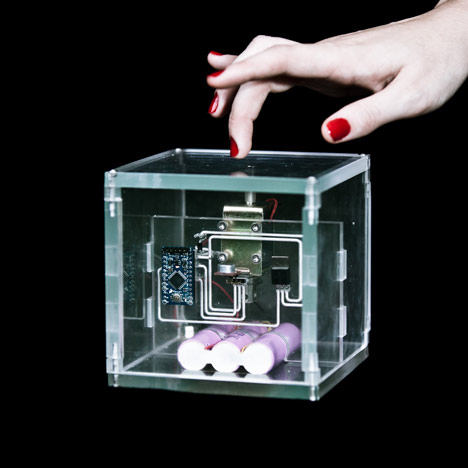Dezeen in Israel: devices that spy, measure, dance and eavesdrop have been added to an exhibition of digital and interactive design that has travelled to the Design Museum Holon.
Top and above: the CUBES project by The Interaction Lab at HIT
Co-curated with digital arts organisation onedotzero, Decode: Digital Design Sensations debuted at the Victoria & Albert Museum in London but has been updated to include new exhibits by Israeli designers.
Above: the CUBES project by The Interaction Lab at HIT
Research group The Interaction Lab at HIT has produced twenty different mechanical cubes, including one that measures distances, another that moves erratically after being shaken and a pair that tap at each other.
Above: the CUBES project by The Interaction Lab at HIT
Next up, artists Amnon Dekel and David Opp present a device that listens to nearby conversations and presents similar topics as images and words on a flashing LED screen.
Above: DEVICEINTERFERENCE [0.3] by Amnon Dekel and David Opp
The third new project, by designer Mushon Zer Aviv, is a virtual confession booth that spys on websites to expose how they are sharing information about their visitors - you can download this plugin for your web browser here.
Above: DEVICEINTERFERENCE [0.3] by Amnon Dekel and David Opp
The exhibition opened in November and continues until 10 March 2012.
Above: DEVICEINTERFERENCE [0.3] by Amnon Dekel and David Opp
You can read more about the original exhibition at the V&A in our earlier story here.
Above: Good Listeners by Mushon Zer Aviv
To see more images of the Design Museum Holon, which was designed by Ron Arad, click here.
Above: Good Listeners by Mushon Zer Aviv
Here's some more text from Design Museum Holon:
Decode: Digital Design Sensations
Design Museum Holon, Israel
In partnership with V&A and onedotzero
Design Museum Holon and the V&A are pleased to announce details of specially commissioned works by Israeli artists and designers for the new exhibition Decode: Digital Design Sensations which have been generously supported by the Porter Foundation. The exhibition has been expanded to include Good Listeners by Mushon Zer Aviv, CUBES by The Interaction Lab and DEVICE INTERFERENCE [0.3] by Amnon Dekel and David Opp.
Curated by Louise Shannon, Deputy Head of Contemporary Programmes, V&A and Shane Walter, Director of digital arts organisation onedotzero, the exhibition shows the latest developments in digital and interactive design, from small screen based graphics to large- scale installations.
Good Listeners by Mushon Zer Aviv is a browser plug-in that exposes the secret way in which our browsing habits are shared with and mined by third-party web services such as Google Analytics and Facebook ‘Like’ without users’ consent or knowledge. Every time a site exposes visitor data to a third party service, a confessional booth window opens in the Good Listeners sidebar. The priest in the window encourages the visitor to share more information by saying “Tell me more...”, “Let it all out...”, “I am always there...”, “You can trust me...”. Each third party service opens its own confessional window sized by the scope and depth of the data it accumulates, presenting a satirical visualisation of the vast data passively generated by us and aggressively collected and mined by mysterious but omnipresent forces of the web.
The CUBES project by The Interaction Lab at HIT deals with the basic idea inherent to interaction: that of action and reaction. The 20 cubes respond to stimuli from the viewer such as presence, light, motion and distance. In response the cubes expand, show movement patterns, emit soap bubbles, become illuminated and more, revealing their inner mechanisms and celebrating the beauty and complexity of the world of electronic components.
DEVICEINTERFERENCE [0.3] by Amnon Dekel and David Opp explores the way in which mobile phones broadcast information at all times. This information can be captured, deciphered and changed, making the fabric through which we communicate with others sensitive to attacks and manipulations. The exhibit ‘listens’ to people and their phones as they walk by, eavesdropping by the use of embedded surveillance microphones. At the same time electromagnetic radio waves emanating from nearby phones are also captured, measuring the frequency of the radio waves, the number of phones and their activity. The results are used to pull relevant information from the web via Google and meshed to create an audiovisual experience through the large LED display and speakers in the Museum space.
The exhibition explores three themes in digital and interactive design: Code, Interactivity and Network. Code presents pieces that use computer code to create new designs in the same way a sculptor works with materials such as clay or wood. This section looks at how code can be programmed to create constantly fluid and ever-changing objects.
Interactivity looks at designs that are directly influenced by the viewer; visitors will be invited to interact with and contribute to the development of the works, many of which show designers playing with the boundaries of design and performance.
The final theme, Network, focuses on works that comment on and utilise the digital traces left behind by everyday communications, from blogs in social media communities to mobile communications or satellite tracked GPS systems. This section explores how advanced technologies and the internet have enabled new types of social interaction and media for self expression. Designers reinterpret this information to create works that translate data into striking forms.
During the exhibition, 3rd year students of HIT, in their first semester, will also have the opportunity to practice their interaction design course in the Museum’s Design Lab.

